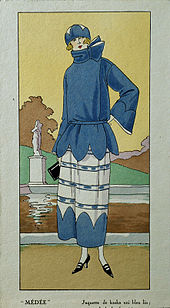


Western fashion in the 1920s underwent a modernization. Women's fashion continued to evolve from the restrictions of gender roles and traditional styles of the Victorian era.[1] Women wore looser clothing which revealed more of the arms and legs, that had begun at least a decade prior with the rising of hemlines to the ankle and the movement from the S-bend corset to the columnar silhouette of the 1910s. Men also began to wear less formal daily attire and athletic clothing or 'Sportswear' became a part of mainstream fashion for the first time.
Fashion in the 1920s was largely impacted by women. They challenged the standard of femininity through clothing, as many of their typical dress items were impractical to move around in. For many, fashion had become a symbol of women's social liberation or the modernization of womanhood. However, it had also become a place where slim body structures and restraints of gender roles were implied.[1]
The 1920s are characterized by two distinct periods of fashion: in the early part of the decade, change was slower, and there was more reluctance to wear the new, revealing popular styles. From 1925, the public more passionately embraced the styles now typically associated with the Roaring Twenties. These styles continued to characterize fashion until the worldwide depression worsened in 1931.
- ^ a b Strassel, Annemarie (2012). "Designing Women: Feminist Methodologies in American Fashion". Women's Studies Quarterly. 41 (1/2): 35–59. ISSN 0732-1562.